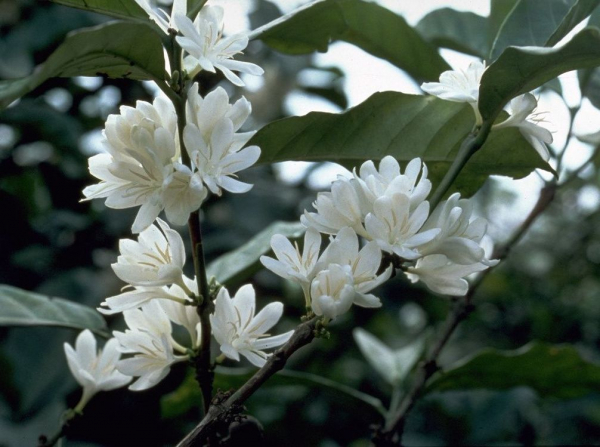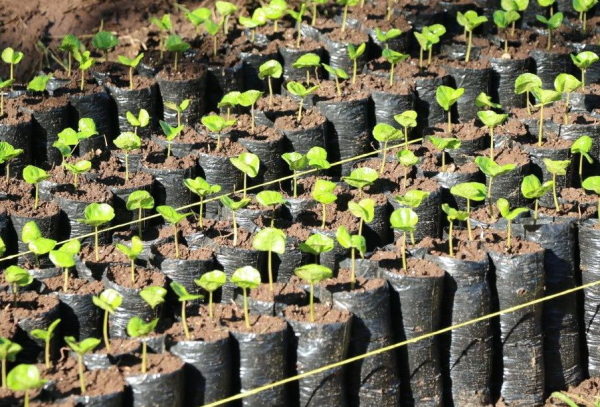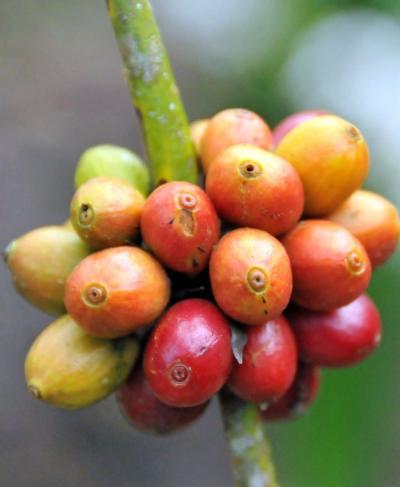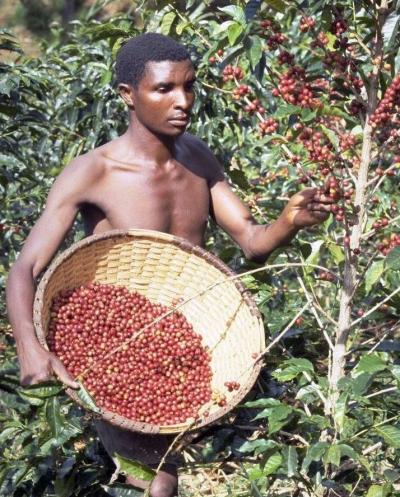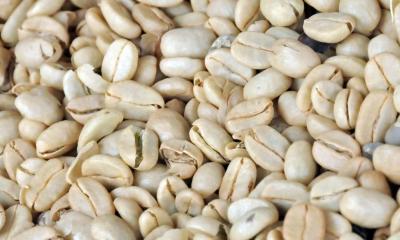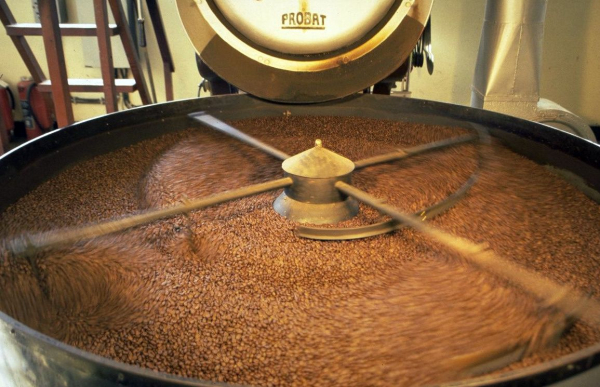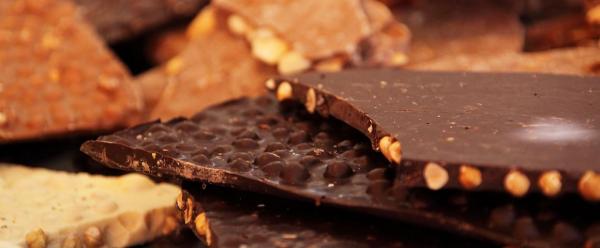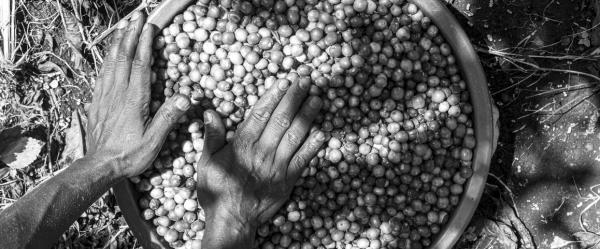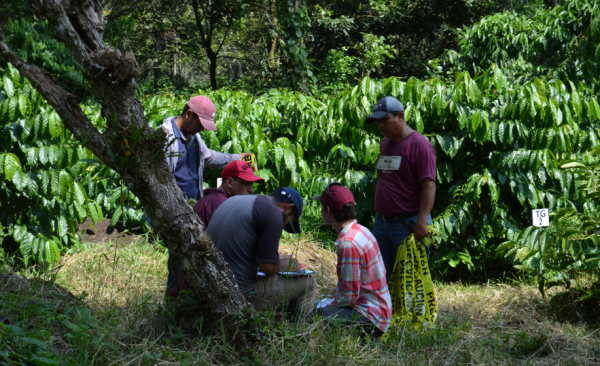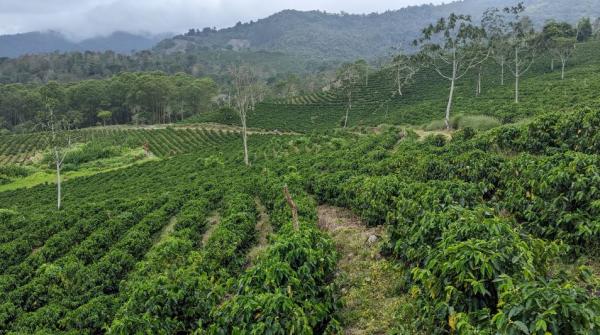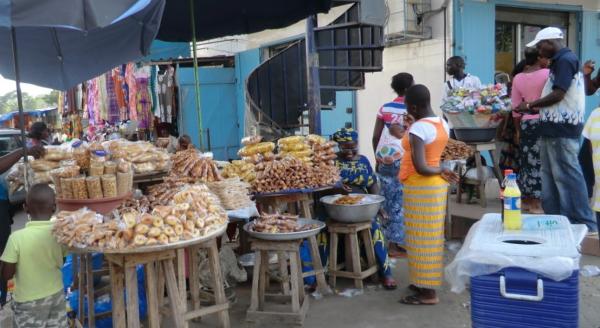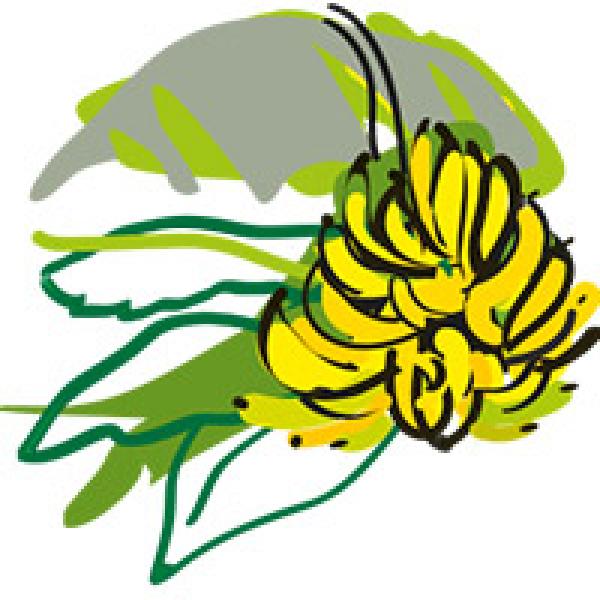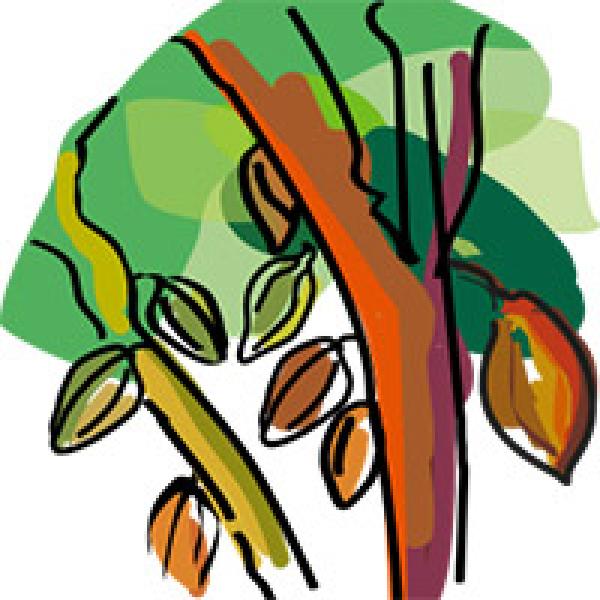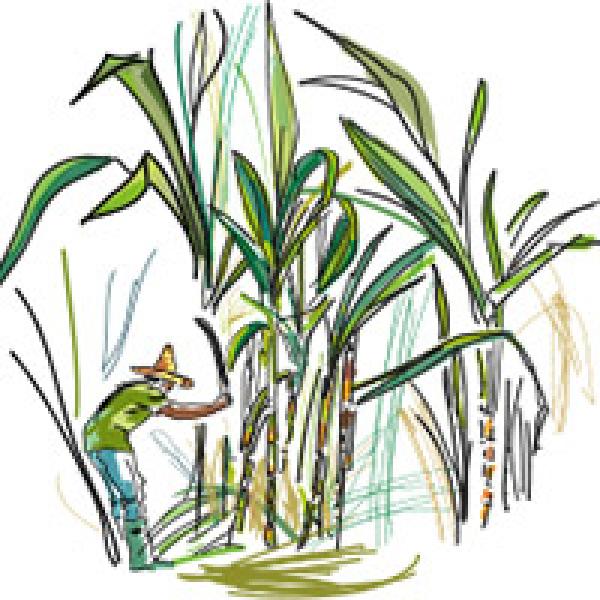Results & impact 20 August 2025
- Home
- Our activities, our impact
- Tropical value chains
- Coffee

Coffee
Coffee trees are shrubs of the genus Coffea, which includes almost 80 species. Two species, Coffea arabica and C. canephora, originated in Africa, are cultivated for their seeds which, after roasting, give coffee: the first produces Arabica coffee, the second the Robusta. The taste of coffee, its very specific aroma, and its stimulant effects have all contributed to its success. And even more, the unique and friendly atmosphere that developed in the places where it is consumed.
Upland and lowland coffees
Coffee trees are evergreen shrubs of the family Rubiaceae. Coffea arabica originated in Abyssinia; it is found in the forests of the Ethiopian uplands, where it has been picked for centuries. The species comprises the varieties Typica, Maragogype, Bourbon, Blue Mountain and Mundo Novo. Arabica has traditionally been seen as better quality, in view of its fine flavour, mildness and easily recognizable smell, and also its low caffeine content. The species Coffea canephora, which produces Robusta coffee, grows wild on the sub-equatorial plains of West and Central Africa. Robusta, with a more ordinary taste than Arabica, has a high caffeine content.
Arabica coffee trees grow up to 5 or 6 m tall and Robusta 10 to 12 m. The trees are then pruned to a height of 2 to 3 m. The oval leaves are evergreen and shiny. They grow in pairs, one each side of the stem. Coffee can bear flowers and fruits of varying degrees of ripeness at the same time.
Several times a year, particularly at the end of the dry season, coffee trees are covered in very strongly scented white flowers that grow in the leaf axils. The flowers are pollinated by insects and the wind. The short-lived flowers fade directly after pollination, becoming fruits after two to three months. They are then replaced by other flowers.
The fruits are initially green and then turn yellow and eventually bright red. They are the size of a cherry, and indeed are commonly known as cherries. They grow in tight bunches in the leaf axils of young branches. The fruit comprises a skin, varying quantities of sweet, yellowish-white pulp and two oval seeds, side by side. Robusta cherries ripen within eight to twelve months and Arabica in six to eight months. Each seed is surrounded by a pale yellow sheath called the parchment.
Arabica originated in Ethiopia and spread via Yemen to the rest of the world. Coffee was claimed to facilitate nocturnal religious ceremonies by keeping the participants awake, and as such was drunk by the Sufis of Yemen as early as the 14th century. The beans used to prepare it were imported from the Kaffa region in Ethiopia. The beverage very quickly spread to the sacred sites of Islam such as Mecca and Medina, and left the closed world of the Sufis for public coffeehouses, in Baghdad, Damascus and Alexandria, and then in Constantinople, in 1554. Yemen began to produce coffee in the first half of the 16th century, by which time the drink had already conquered the whole of the Arabian peninsula and the Middle East. Europe was quick to follow suit.
Throughout the 17th century, there were prosperous plantations in Yemen. After growing rich from the spice trade, the town of Mocha on the Red Sea thrived on the coffee trade, becoming the world’s largest export port. Until the 18th century, coffee, which came from the countries of the Levant, was very costly and highly coveted. The sultan of the Ottoman Empire found a radical way of protecting his monopoly: before shipment, all the bags were inspected and the coffee beans blanched to prevent them germinating and being grown elsewhere. However, in the 17th century, the Dutch managed to obtain a few beans that they planted in India, Ceylon and then Java. They also opted for a monopoly, and imposed the death penalty for anyone trying to export plants from their colonies. However, they did give one plant to every botanical garden in Europe. In 1714, the representative of the Dutch East India Company gave some coffee trees to Louis XIV. The young plants were acclimatized at the Jardin du Roi in Paris (now the Jardin des Plantes), and were the ancestors of the first plants grown in the French colonies in the Americas, particularly Martinique, from where coffee spread to Latin America.
Arabica and Robusta do not require the same type of care
Each species has its own ecology. Arabica likes cool climates without frost, and prefers mountain ecologies. It is thus found in the uplands of East Africa (where it originated), the volcanic areas of central America and the Andean slopes of South America. However, some of the main production zones, such as Brazil, are not high-altitude areas.
Robusta prefers low altitudes and hot and humid equatorial-type climates, where cocoa and banana also grow. The main production zones are the plains of West Africa, Vietnam and Indonesia.
Arabica can adapt well to tropical climates tempered by altitude. However, it will not grow on the plains of equatorial and subtropical zones, which are either too hot or too humid. At the end of the 19th century, the discovery of Robusta in the Congo opened the way for coffee growing on lowland areas. The name Robusta is far from a misnomer: the variety is more vigorous and disease resistant, and also higher-yielding. It was not until the early 20th century that colonial Robusta plantations really took off. The spread was halted by the Second World War and resumed in Africa after the wave of independence, supported by the new governments and with strong support from smallholders, particularly in Cameroon and Côte d’Ivoire. Robusta did not restrict itself to Africa. It also spread to northern Brazil and Asia: Indonesia, India, the Philippines and then Vietnam, which is now the world’s second largest coffee producer.
Arabica varieties are grown from seed as they are self-fertilizing. The species is thus classed as autogamous. The seeds can only germinate for a short time (a few months after harvesting). They germinate within two months or so, and are transferred to the nursery at the “little soldier” stage, where they remain for around nine months before being planted out in the field.
Robusta is traditionally grown from cuttings, as it is allogamous: the progenies of a given coffee tree fertilized by pollen from outside are very heterogeneous. The best coffee trees are propagated by planting half-stems with leaves in cutting trays. Once the cutting has rooted, it is transferred to the nursery for a few months before being planted out. In vitro plantlets can also be produced.
Arabica is planted at densities of between 3 000 and 10 000 plants per hectare. It begins to bear after two to three years. Flowering is triggered either by cold or by a dry period. In the event of a very marked dry season, the trees may flower once or twice a year. In the cold and constantly rainy climates of mountain areas, coffee trees may flower four or five times, if not more, over several months. Fruit set (the time the fruits take to ripen) lasts six to ten months. Annual upkeep is restricted to pruning, weeding, fertilization and sometimes phytosanitary treatments against pests and diseases.
Robusta is grown in a similar way to Arabica. However, it is often grown in the open, at lower densities (1 000 to 3 000 plants per hectare). The fruit set time is shorter.
The threats to coffee trees
The parasite that causes the most damage worldwide is a very small beetle, the coffee berry borer (Hypothenemus hampei), which bores holes in the cherries. This causes losses in terms of yield, but also of quality. For some time now, clean, rational methods have been available for integrated management of the coffee berry borer, but few growers use them, primarily for financial reasons.
The most serious disease is coffee berry disease, caused by a fungus, Colletotrichum kahawae. It primarily affects East Africa, and can wipe out up to 90% of the harvest in some years. The priority in the drive to overcome this problem is to develop resistant varieties.
Coffee trees have many other natural enemies, such as nematodes, which attack the roots, coffee leaf rust (another fungal disease), bugs, aphids, scale insects, etc. However, generally speaking, few growers take control measures and coffee is often grown “naturally”.
Cherry harvesting
Harvesting is primarily done by hand, as there may be fruits at every possible stage of ripeness on a given coffee branch. The ideal method is to pick only ripe, bright red fruits, cherry by cherry. However, this is highly labour-intensive and means returning to each coffee tree four or five times during the harvest. It is used for high-quality coffees (Arabica).
Coffee growers often prefer another, faster method, strip-picking, which consists in stripping all the cherries on a given branch. This results in coffees of very inconsistent quality. Robusta is often harvested in one or two stages, as quality is rarely a priority for this variety.
Dry cherry and parchment coffee
There are two ways of preparing coffee beans after harvesting: wet and dry.
The dry method produces dry cherry. The cherries are spread out in thin layers (3 to 4 cm thick) in the sun, on concrete, mats or tarpaulins. They have to be stirred regularly and sheltered during the night or when it rains. Drying takes around 20 days, and reduces the moisture content of the cherries from 70 to 12%. The different sheaths (skin, pulp and parchment) dry out to form a shell. Once the beans rattle around in the shell, the coffee is dry.
The wet method produces dry parchment coffee. The wet method comprises several stages: pulping, mucilage removal, washing and densimetric grading in water, and drying. The skin and some of the mucilage are removed in a mechanical pulper, without damaging the parchment or the bean. The remaining mucilage is broken down by microbial means (fermentation) or mechanically. The coffee is then washed in water to prevent microorganism development, particularly during drying. Washing is done by hand, in tanks or channels, which means that the beans can also be graded according to density, eliminating light beans and foreign bodies. After washing, the bean with just its parchment coating is wholly sun-dried, wholly machine-dried or a mixture of the two (sun- and then machine-drying). This reduces the coffee moisture content from 55% to 12%. Fermentation and soaking reduce bitterness and astringency, increase acidity and result in a finer flavour.
Commercial green coffee
Once dry, parchment coffee and dry cherry can be stored and transported. However, to produce commercial green coffee, they have to be stripped of their coatings. Shelling dry cherry produces unwashed green coffee. Hulling parchment coffee produces washed green coffee. Green coffee is graded according to bean size, and then sorted densimetrically. There is a final colorimetric or manual sorting operation to eliminate beans with colour defects: black beans, which make the coffee taste bitter, unclean and earthy; white beans, which make it taste flat and woody; brown beans, which give a rummy, sour and unpleasantly fruity flavour.
Green Arabica coffee beans, which are large, elongated and flat, are a bluish-green colour, while green Robusta beans are smaller, round, and brown.
It is better to store green coffee than roasted coffee, as the former keeps its flavour for longer. It is generally stored in jute bags of around 60 kg. It is roasting that eventually reveals the quality of its flavour, and thus of the work done since the beans left the plantation.
Storage conditions can still affect commercial coffee quality. In particular, coffee placed in storage should not have too high a moisture content (no more than 12.5%).
It is before roasting that most industrialists mix their green coffees. The final blend sometimes contains more than seven different origins.
Roasting releases flavour
Households used to roast their own coffee, but this crucial operation is now done by specialists.
It is at this point that the roaster or master roaster heats the green coffee bean, which does not have any flavour, to produce a brown bean with a complex flavour comprising around 800 aromatic compounds.
The roasting time and temperature depend on the technique used: traditional roasting (around 20 minutes at 200°C), faster roasting (10 minutes at 250°C) or flash roasting (90 seconds). They also vary according to taste: very lightly roasted beans give a more acidic coffee with a hint of toast or cereal to which Americans are partial. The longer the beans are roasted, the greater the bitterness and the lower the acidity. Dark roasted beans, which are popular in France, give a more balanced beverage, while Italian-style roasting increases bitterness.
An active ingredient: caffeine
Coffee comprises around 55% total polysaccharides, 8 to 15% fat depending on the variety, and approximately 11% proteins. It also contains 10 to 13% water, alkaloids (including caffeine), vitamins (PP, B3), and minerals (sodium, magnesium, potassium, calcium, phosphorus, etc).
There are around 800 different compounds in roasted coffee.
Caffeine belongs to the xanthine family of alkaloids. It was isolated in 1820. Arabica contains around 1.5% and Robusta between 1.6% and 2.8%, and occasionally up to 3.5%. Caffeine has significant physiological effects that vary from one person to another. It stimulates the central nervous system and the cardiovascular system.
Contrary to popular belief, it is not an antidote to alcohol. It is absorbed very rapidly by the body and metabolized by the liver to form various xanthines, which are excreted in the urine. The degree of elimination varies from person to person, and care should be taken not to consume more than 600 mg per day. The amount of caffeine in a 100-ml cup of coffee varies between 60 and 120 mg, depending on the type of coffee used and how it is prepared.
There are two industrial processes for making instant coffee: freeze drying and spray drying. Freeze drying consists in freezing an aqueous coffee concentrate, followed by vacuum evaporation. The water therefore passes directly from a solid to a vapour state, bypassing the intermediate liquid phase (this is known as sublimation).
Spray drying is cheaper, and consists in spraying the concentrated liquid coffee extract under high pressure in a hot air flow. The heat evaporates off the water, leaving fine coffee powder particles. Decaffeinated coffee is made from green coffee, from which the caffeine is generally extracted using a chlorinated solvent. Other methods use water or liquid carbon dioxide in a supercritical state.

























